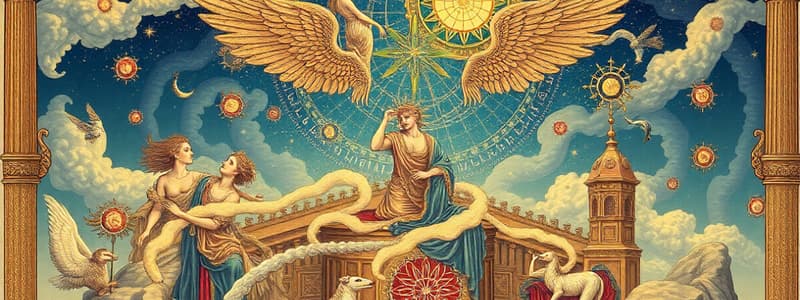Podcast
Questions and Answers
¿Cómo concebía Hesíodo el universo según sus obras?
¿Cómo concebía Hesíodo el universo según sus obras?
- Como un sistema matemático preciso.
- Como un ciclo temporáneo de sucesos.
- Como una jerarquía de deidades y fuerzas naturales. (correct)
- Como un vacío sin estructuras.
¿Cuál es el significado del término 'kháos' en la obra de Hesíodo?
¿Cuál es el significado del término 'kháos' en la obra de Hesíodo?
- Un estado de orden absoluto.
- Un vacío existencial.
- Un estado primordial de nada. (correct)
- Un espacio astronómico singular.
¿Cómo describe Hesíodo la tierra en su cosmología?
¿Cómo describe Hesíodo la tierra en su cosmología?
- Como un disco plano. (correct)
- Como una red de conexiones mágicas.
- Como un punto definido en el espacio.
- Como una esfera en expansión.
¿Qué aspecto destaca la representación del inframundo en la cosmología de Hesíodo?
¿Qué aspecto destaca la representación del inframundo en la cosmología de Hesíodo?
¿Cuál es la relación entre los movimientos de dioses y titanes y el cosmos según Hesíodo?
¿Cuál es la relación entre los movimientos de dioses y titanes y el cosmos según Hesíodo?
¿Qué característica de la obra de Hesíodo se destaca en su tratamiento del cosmos?
¿Qué característica de la obra de Hesíodo se destaca en su tratamiento del cosmos?
¿Qué limitación se menciona sobre las descripciones cosmológicas de Hesíodo?
¿Qué limitación se menciona sobre las descripciones cosmológicas de Hesíodo?
¿Cuál es una de las contribuciones de Hesíodo a la cosmología griega antigua?
¿Cuál es una de las contribuciones de Hesíodo a la cosmología griega antigua?
Flashcards
Cosmología de Hesíodo
Cosmología de Hesíodo
Hesíodo, un poeta griego, no habló explícitamente sobre el "espacio" en el sentido científico moderno. Se concentró en la cosmología, el origen y la estructura del cosmos.
Obras de Hesíodo
Obras de Hesíodo
La obra de Hesíodo, Trabajos y días y Teogonía, ofrece ideas sobre cómo los antiguos griegos concebían el universo físico y sus orígenes.
Estructura del universo de Hesíodo
Estructura del universo de Hesíodo
El universo de Hesíodo no es un vacío amplio y vacío, sino una estructura jerárquica compleja llena de deidades y fuerzas naturales.
La tierra en la concepción de Hesíodo
La tierra en la concepción de Hesíodo
Signup and view all the flashcards
El cielo según Hesíodo
El cielo según Hesíodo
Signup and view all the flashcards
Cosmología mítica de Hesíodo
Cosmología mítica de Hesíodo
Signup and view all the flashcards
Kháos en cosmología de Hesíodo
Kháos en cosmología de Hesíodo
Signup and view all the flashcards
Jerarquía del cosmos de Hesíodo
Jerarquía del cosmos de Hesíodo
Signup and view all the flashcards
Study Notes
Hesíodo and Space
- Hesíodo, a Greek poet, did not explicitly discuss "space" in the modern scientific sense. His focus was on cosmology, the origins and structure of the cosmos.
- His Works and Days and Theogony offer insight into how the ancient Greeks conceived the physical universe and its origins.
- Hesíodo's universe is not a vast, empty void but a complex, hierarchical structure filled with deities and natural forces.
- The earth was envisioned as a flat disk, a foundational element, not a defined point in space. The heavens, a dome-like structure, rested above it.
- Hesíodo's cosmological descriptions lack rigorous mathematical or physical laws. The elements are interwoven with mythology, creating a narrative rather than a precise model.
- The concept of "kháos" represented the primordial void or state of nothingness from which the cosmos emerged. This was not an empty space but a chaotic, formative condition.
- Hesíodo's depiction of other realms, like the Underworld, shows a layered view of the cosmos, not just a spatial concept, but a hierarchy of existence.
- The movements of gods and titans represented cosmic activity, understood as physical processes influencing the world, not just divine actions.
- Hesíodo's descriptions of the earth's features, like mountains and rivers, were part of the cosmogonic narrative, implying a specific configuration within the wider cosmos.
- The lack of precise mathematical or scientific explanations does not diminish the work's poetic and symbolic value, but offers insight into the ancient Greek understanding of both the physical and spiritual worlds.
- His perspective reveals the Greek worldview's emphasis on the interconnectedness of the divine and natural realms, rather than a purely geometrical or spatial understanding of the universe.
- It's important to differentiate Hesíodo's mythical portrayal of the cosmos from later scientific approaches.
Studying That Suits You
Use AI to generate personalized quizzes and flashcards to suit your learning preferences.
Description
Este cuestionario explora las ideas de Hesíodo sobre la cosmogonía y la estructura del universo según la mitología griega. A través de sus obras como Obras y Días y Teogonía, se examina cómo los antiguos griegos entendían el cosmos y su origen. Descubre la relación entre la mitología y la concepción del espacio en la Antigua Grecia.




